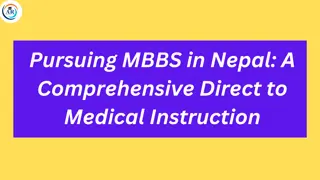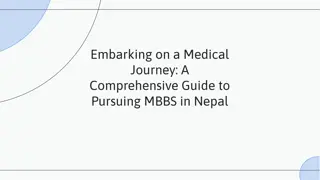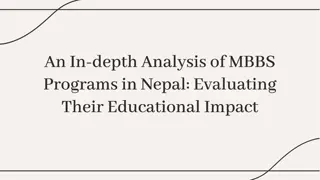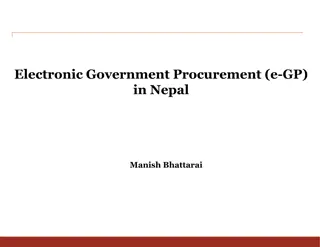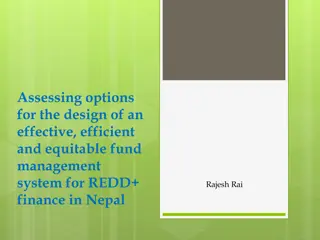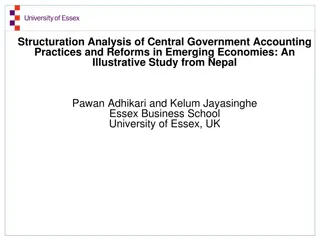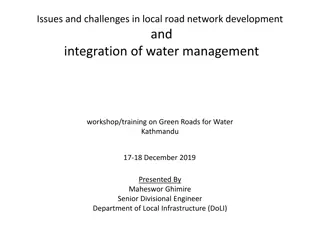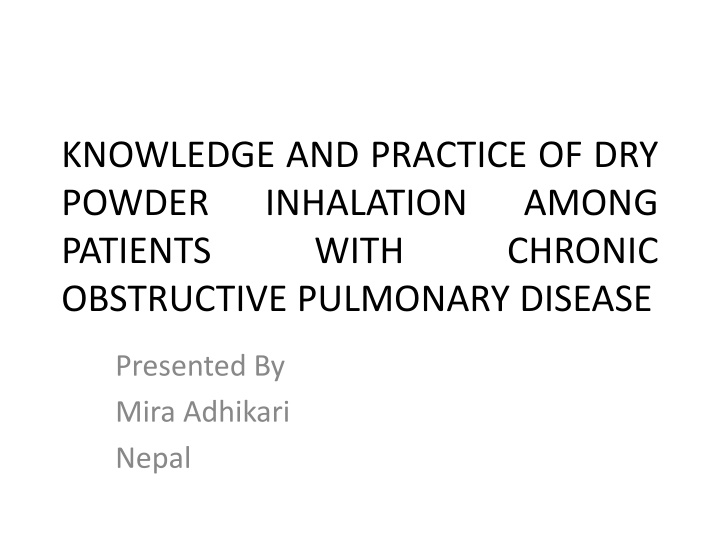
Dry Powder Inhalation in Patients with Obstructive Pulmonary Disease
Understanding the knowledge and practice of dry powder inhalation in patients with obstructive pulmonary disease (COPD) is crucial for effective management of this life-threatening condition. COPD, comprising chronic bronchitis and emphysema, is a major cause of morbidity and mortality worldwide. In Nepal, COPD is prevalent among adults, leading to significant hospitalizations. Pharmacological therapies, including aerosol treatments with anticholinergics and corticosteroids, offer advantages in delivering medication directly to affected areas with rapid action and minimal side effects. Inhaler devices such as pressurized metered-dose inhalers, dry powder inhalers, and mist inhalers play a vital role in effective medication delivery for COPD patients.
Download Presentation

Please find below an Image/Link to download the presentation.
The content on the website is provided AS IS for your information and personal use only. It may not be sold, licensed, or shared on other websites without obtaining consent from the author. If you encounter any issues during the download, it is possible that the publisher has removed the file from their server.
You are allowed to download the files provided on this website for personal or commercial use, subject to the condition that they are used lawfully. All files are the property of their respective owners.
The content on the website is provided AS IS for your information and personal use only. It may not be sold, licensed, or shared on other websites without obtaining consent from the author.
E N D
Presentation Transcript
KNOWLEDGE AND PRACTICE OF DRY POWDER INHALATION PATIENTS WITH OBSTRUCTIVE PULMONARY DISEASE AMONG CHRONIC Presented By Mira Adhikari Nepal
Introduction Chronic obstructive pulmonary disease (COPD) is a life threatening disease. It is a lung disease characterized by chronic obstruction of lung airflow that interferes with normal breathing and is not fully reversible.1 Chronic bronchitis and Emphysema fall under COPD.1
It increasingly is a cause of morbidity and mortality and economic burden on the healthcare system.2-3 An estimated annual death of 3 million people (5%) occur due to pulmonary disease making it the fourth leading cause of death in the world.4 chronic obstructive
Around 90% of these deaths occur in low- and middle-income countries.4 By 2020, COPD is anticipated to become the third leading cause of death in the world.5 In Nepal, COPD is prevalent among 18.3% of the total adults.6
A hospital based prevalence showed that COPD comprises noncommunicable disease and 2.56% of all hospitalization in Nepal.7 Pharmacological therapies for COPD includes bronchodilators(B2 agonists), antmuscarinic drugs/ anticholinergics, methylxanthines and inhibitors. 43% of the corticosteroids, phosphodiestrse-4
Among anticholinergics and corticosteroids are best administered through aerosol therapy.5,8,9 Aerosol treatment as the main stay of treatment in COPD has many advantages over oral intake as inhalation promotes supply of drug directly to the affected site and has less side effects. those drugs bronchodilators,
Moreover, the action of drug is rapid and small dose of drug is required to achieve therapeutic effect.10
Aerosol drugs require inhaler devices to inhale the drugs effectively. pressurised metered-dose inhalers (MDI), dry powder inhalers (DPI) and mist inhalers.11 These inhalers have their own advantages and disadvantages These include
DPI is commonly used among patients with higher inspiratory flow rate to disperse the drug to the targeted site. It is easy to use as no coordination is require between activation inhalation.12,13,14 of inhaler and
The effectiveness of the inhaled drug depends on how correctly one inhales aerosol drug through the inhaler device. Incorrect inhalation inadequate drug delivery to lungs and hence worse COPD outcomes.2,3,15, Rotahaler is a commonly use dry powder inhaler device.11 technique results in
Although correct technique of inhalation is necessary to achieve the effectiveness of the drug, a large proportion undergoing inhalation rotahaler do not use the correct inhaler technique. A systematic study has shown that poor inhalation technique range from 4 to 94%.16 of patients through treatment
The resultant outcome thus is frequent COPD exacerbations and hospital admissions and economic burden.2,3,15,16 Studies have shown that various factors affect the inhalation technique of patients. These include their related age, sex, educational status, occupation, area of residence, duration of disease, and poor inhalation instruction. 17,18,19,20
Although rotahaler is a preferred dry powder inhaler device among physicians in Nepal, very limited attempts have been made to study how well the COPD patients use the device. Moreover, those studies have been conducted only at the central level.
This scenario of the practice and increasing burden of COPD in Nepal and escalating use of dry powder inhalation for its treatment without due consideration to evaluation of patients skill about its correct use has become a serious concern in creating the effective treatment of COPD and achieving the goals of national policy regarding reducing the burden of Non Communicable disease by 25% till 2020.
With this view of above facts and interest in the topic, the present study was undertaken to assess the level of Knowledge and practice of dry powder inhalation among COPD patients in a regional level hospital
Conceptual Framework The conceptual framework is developed to reveal the factors that could contribute to knowledge and practice of Dry Powder inhaler (rotahaler). The framework considers that socio demographic factors (age, sex, place of residence, education status and employment status) and health care provider related factors (verbal instruction and demonstration by health care providers about DPI use) which are perceived as factors affecting COPD patient s use of DPI in this study.
Similarly, experience with use of dry powder inhalation including years of use of inhaler and experience with family members and friends, instruction provided in leaflet of medicine and information from media can also affect the knowledge and practice of dry powder inhalation.
However these factors have not been taken for consideration in this study.
Conceptual Framework Figure 1: Conceptual Framework on Knowledge and Practice of Dry Powder Inhalation among COPD Patients
Research Methodlogy Research Design: Descriptive cross sectional Study Site: Western Regional Hospital Study Population: Patients diagnosed COPD attending Medical OPD or admitted in Medical ward of Western Regional Hospital aged 20 and above, and who had been taking dry powder inhalation through rotahaler as treatment prior to the date of data collection.
From among these patients, those who did not consent to participate in the study were excluded from the study.
Sampling Procedure Sampling technique . COPD patients were purposively sampled. COPD patients of 20 years and above who had been using rotahaler selected Technique: Purposive sampling were purposively
Sample Size Sample size was 204 based on Sample size estimation formula. Sample size (n) =z2pq/L Based on the findings in TUTH Nepal, percentage of patients who demonstrated correct inhalation technique was 14 percentage.18 Assuming it as prevalence of correct DPI (Rotahaler) use among COPD patients, sample size was calculated as:
p= 14%= 0.14 q= 1-0.14= 0.86 l= 5%= 0.05 (allowable error)at 95% Confidence interval Then, sample size (n) = Z 2 PQ/ L2 = 1.96 1.96x0.14 0.86/ (0.0025) =3.84 0.14 0.86/ 0.0025 =0.462336/0.0025 =184.93=185(14) Adding 10% non response 185+19=204 21
Inclusion Criteria COPD patients aged 20 years and above who had been using rotahaler (prior to the time of data collection) and attended Medical OPD or admitted to Medical ward of Regional Hospital Western
Exclusion Criteria COPD patients less than 20 years and/or prescribed DPI for the first time at the time of visit for data collection. Those who did not consent to participate
Research Instrument The tools used were interviewer administered questionnaire to assess the level of knowledge and an observation checklist on rotahaler use. The questionnaire for knowledge consisted of total 16 questions out of which Part I consisted of five question related to demographic variables, Part II consisted of 5 questions related to general information about COPD, experience with DPI use and health care provider related factors while Part III consisted of 6 questions related to knowledge about rotahaler and its use.
The questionnaire was developed by the researcher herself with the help of extensive study and consultation with chest physicians. The observation checklist for the assessment of inhalation technique of rotahaler was adopted from Dutch Asthma Foundation, which was comparatively complete. clearer and
Validity and Reliability The content validity of the instrument to assess inhalation technique was ascertained by adopting the standard checklist Foundation after intense study, consultation with peers, advisors and medical consultants. Likewise, the content validity of the tool for assessment of knowledge was constructed after intense study, consultation with peers, advisors and chest physicians Hospital by Dutch Asthma of Western Regional
Effort was made to make questions clear, orderly set and Questionnaire was language and further translated into Nepali language and again backward to English to maintain stability making consultation with Nepali and English language experts. easy prepared to understand. in English
Pretesting of the instrument was conducted on 21 COPD patients in Bharatpur Hospital in those who meet the sample criteria to identify clarity, adequacy and consistency of the tool. Reliability analysis of the tool was performed by calculating Cronbach s Alpha value. The cronbach s alpha value of the questionnaire was 0.89.
Data Collection Procedure The study was carried out after the approval of research proposal from the Research Committee of TU, IOM, Pokhara Campus and TU Institutional Review Board. The approved proposal along with written request letter from Pokhara Campus was submitted to the Western Regional Hospital for the permission.
Executive director, HOD of Medical Department and in charge of Medical ward and OPD of the hospital were briefed about the objectives, importance of the study and formal permission was taken for the data collection. Data was collected from February 28, 2016 to March 26, 2016. Exit interview technique was adopted for data collection. Patients who exit from the OPD and who were COPD patients aged 20 yrs and above and who had been using rotahaler were identified process and the
They were explained about the purpose of the study and informed verbal and written consent was taken with information about the nature of the study and participants' role in the research. Questionnaire was interviewer in the separate room in the out patient department at the OPD time 9am to 2 pm) . administered by the
After that, assessment of the dry powder inhalation technique was carried out in rotahaler with placebo rotacaps in the same room. While, similar assessment was carried out in the ward at the bedside of patients (before 9 am and after 2 pm). The incorrect skill items were explained to the patient. Then they were shown a video of correct inhalation technique.
Ethical Consideration Study was carried out after the approval of proposal from research committee of Pokhara campus, Tribhuvan University, Medicine and the executive director of Western Regional Hospital. No any vulnerable members were included in the study. Informed verbal and written consent was taken prior to data collection. Data was collected in a separate room nearby OPD to maintain privacy. Institute of
There was no risk involved to the participants. Participants were benefited by correcting their incorrect steps by the researcher. Confidentiality of the maintained by coding the answers. Collected information was used only for the purpose of the study only and the information was not misused for other purposes. Regarding safety considerations, treatment on the respondents was done that make them harm. respondents was no any
Data Analysis The collected data was organized, coded and entered in Statistical Package for Social Science (SPSS) 16 version. The data was analysed by using descriptive statistics like frequency, percentage, mean and standard deviation demographic and health care provider related aspects of dry powder inhalation. to assess the socio
Inferential analysis was done using chi square test of significance to assess the association of knowledge with socio demographic factors and practice of DPI with socio demographic characteristics and related aspects. Level of significance was considered at 5 percent with p<0.05 and 95% confidence interval. health care provider
Regarding Knowledge, total correct answers were given the weightage score 1. Total score of the COPD patients was converted into percentage. On the basis of score percentage, knowledge was classified into poor (less than 50%), satisfactory (50%-70%) and good knowledge ( more than 70%)22
Practice completion of sequential steps for dry powder inhalation correctly through the use of rotahaler checklist. The performance of inhalation was labelled as correct inhalation technique if the respondent performed all the steps of the checklist correctly. The performance was labeled incorrect if the patient could not perform any or some of the critical and/or general steps. was measured on the basis of dry powder
Table1 Socio-demographic Characteristics of COPD Patients Using Rotahaler Socio-demographic Variables Age group in years Up to 60 61-70 71-80 More than 80 Sex Male Female Place of Residence Rural Urban Educational Status Illiterate Literate Literacy Status,(n=64) Can read and write only Basic Education (Grade 1-8) Secondary Education(Grade 9-12) Higher Level Education (more than 12) Employment Status Unemployed Employed n=204 Percentage Number 40 101 42 21 19.6 49.5 20.6 10.3 46.1 53.9 94 110 112 92 54.9 45.1 140 68.6 31.4 64 24 37.5 42.2 12.5 7.8 27 8 5 135 66.2 69 33.8
Table2 Health Care Provider Related Factors Affecting Knowledge and Practice of Rotahaler among COPD Patients n=204 Health Care Provider Related Factors Verbal instruction about DPI use(n=204) Number Percentage Received verbal instruction 202 99.0 Not received verbal instruction 2 1.0 Demonstration about DPI use (n=204) Observed demonstration 27 13.2 Not observed demonstration 177 86.8
Table3 Knowledge about Dry Powder Inhalation Among COPD Patients n=204 Aspects of Knowledge Correct Item Score Correct Item Percentage Site for Storage of Rotacaps 182 89.2 Nature of Breathe during Inhalation 164 80.4 Percentage of drug that reaches lung 35 17.2 Position of Head during Inhalation 49 24.0 Breathe Holding After Inhalation 24 11.7 Cleaning of Rotahaler 132 44.1
Table4 Level of Knowledge about Dry Powder Inhalation Among COPD Patients n=204 Levels Poor knowledge Number Percentage 91 44.6 Satisfactory Knowledge 101 49.5 Good Knowledge 12 5.9
Table5 Practice of Rotahaler Among COPD Patients Steps n=204 No of Correct Responses Item Correct Score Percentage Keep Rotahaler Upright* 202 99.0 Insert Rotacap with transparent end down 190 93.1 Keep Rotacap Horizontal 203 99.5 Rotate both ends to open the capsulet* 193 94.6 Exhale to Residual Volume 48 23.5 Keep Rotahaler Vertical 197 96.6 Keep Mouthpiece between teeth and lips 171 83.8 Slightly extend the head 91 44.6 Inhale forcefully and deeply* 167 81.9 Hold breath for 10 secs 65 35.9 Exhale away from mouthpiece 170 83.3 If powder still remains inside rotahaler, breathe in again and hold breathe for 10 secs 10 4.9 Open the rotahaler and discard the empty capsule 199 97.5
Table6 Practice of Dry Powder Inhalation among COPD Patients n=204 n=204 Practice Number Percentage Essential Steps Correct 158 77.5 Incorrect 46 22.5 All Steps Correct 8 3.9 Incorrect 198 96.1
Table7 Association Variables And Knowledge of Dry Powder Inhalation Socio demographic Knowledge Variables Poor Satisfactory Age Upto 60 17(42.5%) 18(45.0%) Above 60 74(45.1%) 83(50.6%) Sex Male 44(46.8%) 45(47.9%) Female 47(42.7%) 56(50.9%) Place of Residence Rural 50(44.6%) 58(51.8%) Urban 41(44.6%) 43(46.7%) Educational Status Literate 27(42.2) 27(42.2%) Illiterate 64(42.7%) 74(52.9%) Employment Status Employed 24(34.8%) 37((53.6%) Unemployed 67(49.6%) 64(47.4%) Between Demographic n=204 Good 5(12.5%) 7(4.3%) 5(5.3%) 7(6.4%) 4(3.6%) 8(8.7%) 10(15.6%) 2(1.4%) 8(11.6%) 4(3.0%) Chi Square Value( ) 3.958 0.378 2.515 16.181 8.396 P value 0.138 0.828 0.284 .001# .015#
Table8 Association Between Socio Demographic Variables and Practice of Dry Powder Inhalation Variables Practice Correct Incorrect Age (in Yrs) Upto 60 Above 60 Sex Male Female Place of Residence Rural Urban Education Literate Illiterate Employment Status Employed Unemployed 5(7.2%) 3(2.2%) n=204 Chi Square Value( ) p Value 7.092 5(12.5%) 3(1.8%) 35(87.5%) 161(98.1%) .008# 2(2.1%) 6(5.5%) 92(97.9%) 104(94.5%) .737 0.391 1(.9%) 7(7.6%) 111(99.1%) 85(92.4%) 4.395 .018# 6(9.3%) 2(1.4%) 58(90.6%) 138(98.5%) 5.594 .012# 64(92.8%) 132(97.8%) 1.871 0.171
Table9 Association between Health Care Provider Related Factors and Practice of Dry Powder Inhalation n=204 Care Provider related Factors Obtained Verbal Instruction Obtained Not Obtained Practical classes/demonstration of DPI Obtained Not Obtained Practice CorrectIncorrect 8(4.0%) 0(0%) 7(25.9%) 1(0.6%) Chi Square Value( 2) p value 194(96.0%) 2(100%) - - 20(74.1%) 176(99.4%) 33.54 <.001





